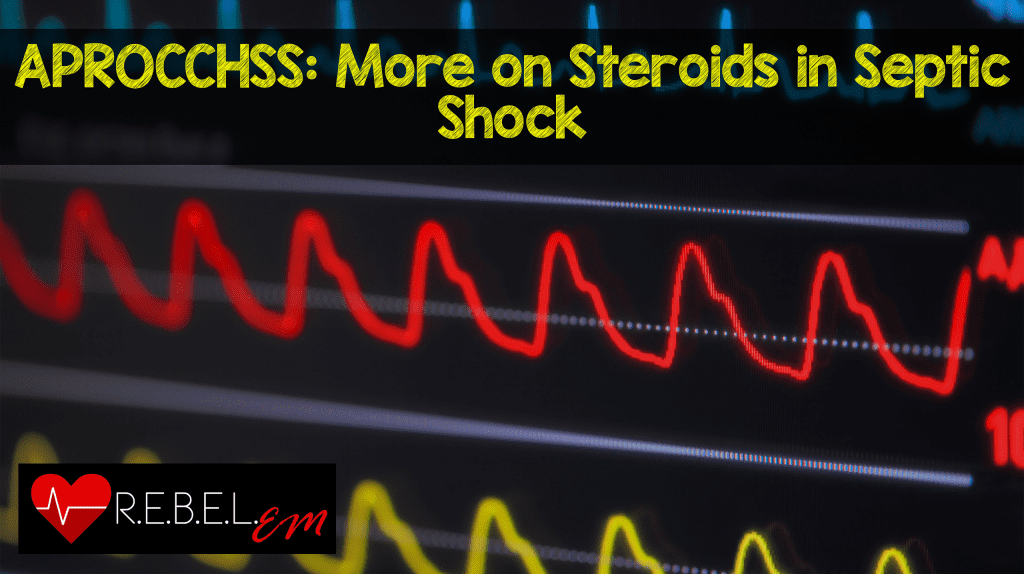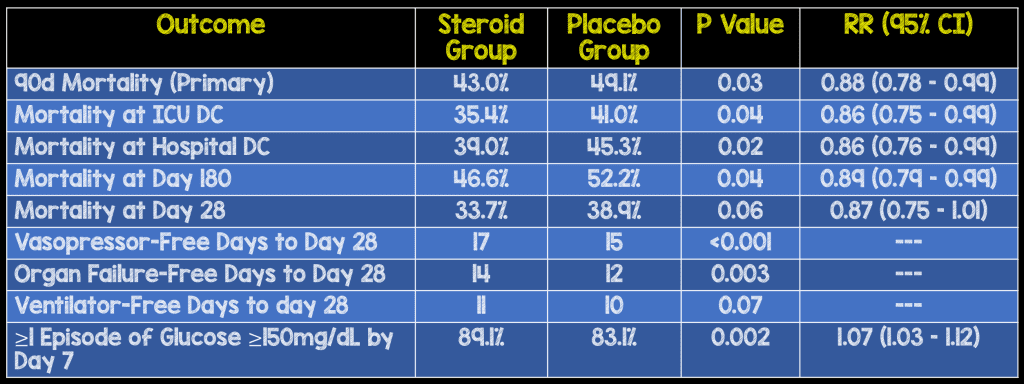 Background: There have now been several trials published on the use of steroids in sepsis. In 2002, we had the Annane Trial, with 299 patients showing mortality and shock reversal benefit in sepsis with hydrocortisone. Then in 2008 we had the CORTICUS trial, with 499 patients, which found a faster reversal of shock, but no benefit in mortality. Next the HYPRESS trial published in 2016 with 380 patients, with severe sepsis, not septic shock, showed no difference in mortality or time to reversal of shock. And finally the ADRENAL Trial published this year with 3800 patients show no difference in mortality, but a small benefit in reversal of shock. Due to these mixed results, many physicians have variable practice patterns with the use of steroids in sepsis/septic shock. Now, we have the APROCCHSS trial looking at hydrocortisone plus fludrocortisone for adults with septic shock (By the way the lead author is the same author that published the 2002 steroids in sepsis trial…Annane).
Background: There have now been several trials published on the use of steroids in sepsis. In 2002, we had the Annane Trial, with 299 patients showing mortality and shock reversal benefit in sepsis with hydrocortisone. Then in 2008 we had the CORTICUS trial, with 499 patients, which found a faster reversal of shock, but no benefit in mortality. Next the HYPRESS trial published in 2016 with 380 patients, with severe sepsis, not septic shock, showed no difference in mortality or time to reversal of shock. And finally the ADRENAL Trial published this year with 3800 patients show no difference in mortality, but a small benefit in reversal of shock. Due to these mixed results, many physicians have variable practice patterns with the use of steroids in sepsis/septic shock. Now, we have the APROCCHSS trial looking at hydrocortisone plus fludrocortisone for adults with septic shock (By the way the lead author is the same author that published the 2002 steroids in sepsis trial…Annane).
Comparison of Steroids in Sepsis Trials:

- The HYPRESS trial was looking at patients with severe sepsis, not just septic shock patients. This is why we see a lower overall mortality in this trial and why we not only see no mortality benefit, but also no shock reversal benefit (septic shock patients were excluded from the trial).
What They Did:
- APROCCHSS (Activated Protein C and Corticosteroids for Human Septic Shock)
- Multicenter, double-blind, randomized, 2 x 2 factorial design trial
- Hydrocortisone + fludrocortisone therapy vs drotrecogin alfa (activated protein C) vs combination of three drugs vs respective placebo
- Drotrecogin alfa was withdrawn from the market, the trial continued with a two-group parallel design comparing hydrocortisone plus fludrocortisone vs respective placebos
- Originally, this trial was supposed to be 4 groups of 320 patients looking for a 10% difference. Since Xigris was removed from market, they condensed into 2 arms of about 620 patients in each arm. This change gave the study power to detect a smaller difference which is why the ~6% diff here is statistically different even though they were shooting for 10%
- Steroid Group: Hydrocortisone 50mg IV q6hrs + Fludrocortisone 50mcg PO qday for total of 7 days without tapering
Outcomes:
- Primary: 90d all-cause mortality
- Secondary:
- Mortality at ICU discharge
- Mortality at hospital discharge
- Mortality at day 28
- Mortality at day 180
- Number of days alive and free of vasopressors, mechanical ventilation, or organ failure
- Safety Outcomes:
- Superinfection up to day 180
- GIB up to day 28
- Episodes of Hyperglycemia up to day 7
- Cognitive impairment and/or muscular weakness at time of ICU and hospital discharge, day 90 and day 180
Inclusion:
- Patients admitted to the ICU <7days
- Suspected septic shock for <24hrs
- Vasopressor therapy at a dose of ≥0.25mcg/kg/min or ≥1mg/hr for ≥6hrs to maintain SBP ≥90mHg or MAP ≥65mmHg
Exclusion:
- Septic shock of ≥24hrs
- High risk of bleeding (Recent trauma or surgery <72hrs, GIB in previous 6 weeks, chronic liver disease, ICH, stroke or head injury in previous 3 months, severe thrombocytopenia <30k, on-going therapeutic anticoagulation)
- Pregnancy or breast feeding
- Underlying conditions that could affect short-term survival
- Known hypersensitivity to drotrecogin alfa
- Previous treatment with corticosteroids
Results:
- 1241 patients included in the trial

- No difference in rate of serious adverse events between groups with the exception of hyperglycemia
Strengths:
- Multicenter, randomized, placebo controlled trial
- Asks a clinically important question that is patient centered
- Trial protocol, amendments, and statistical analysis plan were published ahead of the final results of this trial
- Steroids and placebos had similar appearances helping keep medications blinded
- Patient demographic data and severity of illness scores were similar between groups
Limitations:
- Trial was suspended twice: Once after the withdrawal of Xigris from the market, and once at the request of the data and safety monitoring board to check the quality of trial agents and distribution of serious adverse events (This totaled 2 years of suspension)
- Slightly more viral infections in the hydrocortisone group compared to placebo
- Looking for a 10% mortality difference may have been overly ambitious
- Trial conducted over a long period of time during which our understanding of septic shock has changed as has the overall mortality rate
Discussion:
- The APROCCHSS trial differed from CORTICUS and HYPRESS trials in 2 major ways:
- Fludrocortisone was added to hydrocortisone
- Focus on patients with septic shock whose condition did not improve after initial resuscitation (i.e. patients requiring vasopressors ≥6hrs). This selects patients that are sicker and may be at a higher risk for death
- The fragility index of this trial was 3 – 4. In other words if the trial was larger we could see a regression to the mean based on the small fragility index. This is exactly what we saw in the ADRENAL trial during their interim analyses.
Author Conclusion: “In this trial involving patients with septic shock, 90-day all-cause mortality was lower among those who received hydrocortisone plus fludrocortisone than among those who received placebo.”
Clinical Take Home Point: In patients with septic shock, not improving after initial resuscitation (vasopressor use ≥6hrs) the addition of hydrocortisone + fludrocortisone appears to improve 90d mortality in this trial. However, if you look at all the trials on this topic, we don’t see a consistent mortality benefit compared to placebo. Reversal of shock on the other hand does appear to be improved compared to placebo.
References:
- Annane D et al. Hydrocortisone Plus Fludrocortisone for Adults with Septic Shock. NEJM 2018. PMID: 29490185
For More on This Topic Checkout:
- PulmCCM: Hydrocortisone Plus Fludrocortisone Improved Survival from Septic Shock (APROCCHSS)
- Adrian Wong at The Bottom Line: APROCCHSS – Hydrocortisone and Fludrocortisone in Septic Shock
- Josh Farkas at PulmCrit (EMCrit): APROCCHSS vs. ADRENAL – Are we Asking the Right Question?
Post Peer Reviewed By: @EMSwamiAnand Swaminathan (Twitter: )



